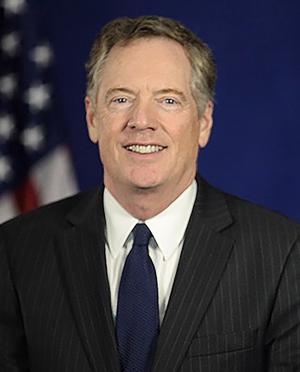With the swearing in of Robert Lighthizer as the new U.S. Trade Representative (USTR) on Monday, the United States has its chief negotiator in place to help protect and expand markets for U.S. feed grains and value-added products around the world.
Floyd Gaibler, U.S. Grains Council (USGC) director of trade and biotechnology, explained that the USTR’s office works on trade issues on three main fronts: defending existing trade agreements, negotiating new trade agreements and handling trade disputes, particularly those involving countries with which the United States does not have a trade agreement.
USGC staff teams up with the U.S. Department of Agriculture’s (USDA) Foreign Agricultural Service (FAS) and USDA’s Animal Plant and Health Inspection Service (APHIS) to tackle specific trade policy issues as they arise. But when these smaller trade barriers become large trade disruptions, Gaibler explained that Lighthizer and the USTR are important partners for addressing concerns in an official manner.
“USTR can help us represent our concerns on a government-to-government basis,” Gaibler said. “USTR also works formally through negotiations with other countries as well as meetings at the World Trade Organization (WTO) and other forums to raise issues about concerns.”
Beyond individual issues, the USTR also represents U.S. agricultural interests during larger trade negotiations like the modernization of existing agreements like the North American Free Trade Agreement (NAFTA) or hammering out new trade agreements like the Transatlantic Trade and Investment Partnership (T-TIP).
For example, the European Union approval process for biotech traits takes more time and is exacerbated with ever increasing submissions and a growing backlog, resulting in trade disruptions that continue to deny the opportunity for U.S. feed grain exports. As a result, USGC continues to work with USDA and USTR to encourage the EU to consider a more systematic and efficient authorization system that is predictable and transparent.
Ultimately, if discussions in these areas fail or countries do not abide by terms of agreements like those made by WTO members, USTR can take legal action in international courts to defend U.S. agriculture’s market access.
“If we encounter a persistent trade irritant that we cannot get resolved on a scientific basis, the next step could logically be to bring in USTR,” Gaibler said. “USTR is always there in the event you cannot reach a practical solution on a trade-related issue.”
These trade policy negotiations do not make snazzy headlines, but make no mistake – the hard work required by organizations like USGC in conjunction with government representation at USDA and USTR is absolutely necessary to protect and expand markets for U.S. feed grains and value-added products.
“As the country’s lead trade negotiator, Lighthizer plays a crucial role in advancing trade discussions and settling disputes, especially on priorities for U.S. agriculture,” said Gaibler. “We look forward to working with Lighthizer and the USTR’s office to enable trade and expand markets for U.S. feed grains and value-added products.”
Learn more about USGC work on trade policy here.


